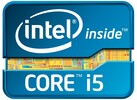Intel Core i5-3340M vs Intel Core i7-6870HQ
Intel Core i5-3340M
► remove from comparison
The Intel Core i5-3340M is a fast dual-core processor for laptops based on the Ivy Bridge architecture. Due to Hyperthreading, the two cores can handle up to four threads in parallel leading to better utilization of the CPU. Each core offers a base speed of 2.7 GHz but can dynamically increase clock rates with Turbo Boost up to 3.2 GHz (for 2 active cores) and 3.4 GHz (for 1 active core). As its predecessor Core i5-3320M, it offers a 3 MB L3-Cache.
Ivy Bridge is an enhanced die shrink of the Sandy Bridge architecture with improvements on both GPU and CPU performance. The CPUs are produced in 22nm (versus 32nm Sandy Bridge CPUs) and are the first to introduce 3D transistors for increased energy efficiency when compared to similarly clocked Sandy Bridge processors. Other new features are integrated PCI Express 3.0 and DDR3(L)-1600 support.
The performance of the Core i5-3340M is slightly above a similarly clocked Sandy Bridge processor due to slight architectural improvements. As a result, overall performance is above the old i7-2640M.
The integrated Intel HD Graphics 4000 offers 16 Execution Units (EUs) clocked at 650 MHz up to 1250 MHz with Turbo Boost, making it one of the faster variants.
Just like most other Ivy Bridge dual-cores, the i5-3340M is rated at a TDP of 35 W. Therefore, even smaller laptops can use the Core i5.
Intel Core i7-6870HQ
► remove from comparison
The Intel Core i7-6870HQ is a fast quad-core processor for notebooks based on the Skylake architecture and was introduced in the beginning of 2016. Besides four CPU cores including Hyperthreading, which are clocked between 2.7-3.6 GHz (probable Turbo steps: 4 cores: up to 3.2 GHz, 2 cores: up to 3.4 GHz), the processor also includes a very fast graphics unit. The Iris Pro Graphics 580 (GT4e) has 72 EUs as well as 128 MB eDRAM cache, which can also be used by the CPU cores. It is manufactured using a 14 nm process with FinFET transistors.
Contrary to other models like the Core i7-6820HQ, the i7-6870HQ does have a much faster GPU, but neither supports the instruction set extensions TSX-NI nor vPro.
Architecture
Intel uses Skylake to replace both Broadwell as well as Haswell and therefore uses one core design for all TDP classes between 4.5-45 Watts. Several improvements of the Skylake architecture include bigger Out-to-Order-Buffer, optimizations for pre-fetching as well as bigger gains by Hyperthreading. However, the changes are small for a "Tock" – a new micro architecture – in general, so the per-MHz performance is only between 5-10 % (compared to Haswell) or less than 5 % higher (compared to Broadwell), respectively.
The i7-6870HQ also benefits from the additional eDRAM cache in some cases, which can accelerate memory-heavy applications in particular.
Performance
Thanks to the additional eDRAM cache, the i7-6870HQ should even compete with the similarly clocked i7-6820HQ and is therefore one of the fastest notebook processors in the beginning of 2016. Even the most demanding applications and excessive multi-tasking are no problem for the high-end CPU.
Graphics
The integrated GPU with the designation Iris Pro Graphics 580 (also known as "GT4e") represents the fastest version of the Skylake GPU (Intel Gen. 9). 72 Execution Units (EUs) run at 350 up to 1000 MHz and allow a performance comparable to a dedicated mainstream chip. The GPU might be able to compete with a GeForce 945M under perfect conditions and it is therefore the fastest iGPU on the market by a pretty big margin. Modern games from 2015/2016 can usually be played smoothly at medium settings. More information about the performance and the features is available on our dedicated page for the Iris Pro Graphics 580.
Power Consumption
According to its TDP of 45 Watts, the chip is primarily designed for bigger notebooks starting with 15-inch screens. The TDP can optionally be reduced to 35 Watts (cTDP down), but this would obviously affect the performance.
| Model | Intel Core i5-3340M | Intel Core i7-6870HQ | ||||||||||||||||||||||||||||||||||||||||||||||||||||||||||||||||||||||||||||||||||||||||||||||||
| Codename | Ivy Bridge | Skylake | ||||||||||||||||||||||||||||||||||||||||||||||||||||||||||||||||||||||||||||||||||||||||||||||||
| Series | Intel Core i5 | Intel Core i7 | ||||||||||||||||||||||||||||||||||||||||||||||||||||||||||||||||||||||||||||||||||||||||||||||||
| Series: Core i7 Skylake |
|
| ||||||||||||||||||||||||||||||||||||||||||||||||||||||||||||||||||||||||||||||||||||||||||||||||
| Clock | 2700 - 3400 MHz | 2700 - 3600 MHz | ||||||||||||||||||||||||||||||||||||||||||||||||||||||||||||||||||||||||||||||||||||||||||||||||
| L1 Cache | 128 KB | 256 KB | ||||||||||||||||||||||||||||||||||||||||||||||||||||||||||||||||||||||||||||||||||||||||||||||||
| L2 Cache | 512 KB | 1 MB | ||||||||||||||||||||||||||||||||||||||||||||||||||||||||||||||||||||||||||||||||||||||||||||||||
| L3 Cache | 3 MB | 8 MB | ||||||||||||||||||||||||||||||||||||||||||||||||||||||||||||||||||||||||||||||||||||||||||||||||
| Cores / Threads | 2 / 4 | 4 / 8 | ||||||||||||||||||||||||||||||||||||||||||||||||||||||||||||||||||||||||||||||||||||||||||||||||
| TDP | 35 Watt | 45 Watt | ||||||||||||||||||||||||||||||||||||||||||||||||||||||||||||||||||||||||||||||||||||||||||||||||
| Technology | 22 nm | 14 nm | ||||||||||||||||||||||||||||||||||||||||||||||||||||||||||||||||||||||||||||||||||||||||||||||||
| Features | HD Graphics 4000 (650-1250MHz), DDR3-1600 Memory Controller, HyperThreading, AVX, Quick Sync, Virtualization | Dual-Channel DDR3L-1600/DDR4-2133 Memory Controller, AVX, AVX2, Quick Sync, Virtualization, AES-NI, TXT | ||||||||||||||||||||||||||||||||||||||||||||||||||||||||||||||||||||||||||||||||||||||||||||||||
| iGPU | Intel HD Graphics 4000 (650 - 1250 MHz) | Intel Iris Pro Graphics 580 (350 - 1000 MHz) | ||||||||||||||||||||||||||||||||||||||||||||||||||||||||||||||||||||||||||||||||||||||||||||||||
| Architecture | x86 | x86 | ||||||||||||||||||||||||||||||||||||||||||||||||||||||||||||||||||||||||||||||||||||||||||||||||
| $225 U.S. | $434 U.S. | |||||||||||||||||||||||||||||||||||||||||||||||||||||||||||||||||||||||||||||||||||||||||||||||||
| Announced | ||||||||||||||||||||||||||||||||||||||||||||||||||||||||||||||||||||||||||||||||||||||||||||||||||
| Manufacturer | ark.intel.com | ark.intel.com | ||||||||||||||||||||||||||||||||||||||||||||||||||||||||||||||||||||||||||||||||||||||||||||||||
| max. Temp. | 100 °C | |||||||||||||||||||||||||||||||||||||||||||||||||||||||||||||||||||||||||||||||||||||||||||||||||
| Socket | BGA |
Benchmarks
Average Benchmarks Intel Core i5-3340M → 0% n=0
* Smaller numbers mean a higher performance
1 This benchmark is not used for the average calculation












